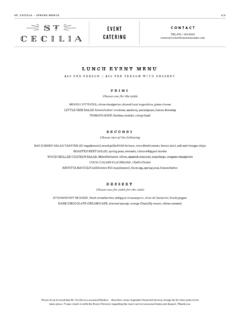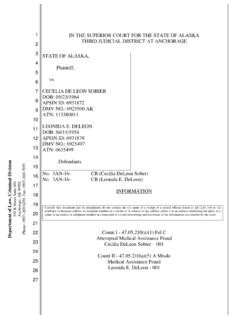Transcription of Skills Center Psychology Practice Exam III - Ranked #1 CT ...
1 Skills Center Psychology Practice Exam III. Psch 101. Professor Bob Beck 1.) The neurons that make initial contact with the environment are a. interneurons. b. motor neurons. c. glial cells. d. sensory neurons. 2.) The neurons that carry messages to muscles and glands that produce behavioral responses are a. motor neurons. b. sensory neurons. c. interneurons. d. glial cells. 3.) Glial cells are the cells in the nervous system that a. remove waste and help neurons communicate more efficiently. b. make the initial contact with the environment. c. convey information from one internal processing site to another. d. carry messages and commands away from the brain and spinal cord. 4.) Because reflex pathways are controlled primarily by spinal cord pathways a. individuals typically respond slowly to painful stimuli and events. b.
2 Individuals are able to respond more quickly to painful stimuli and events. c. individuals will only show adaptive reflexive responses when the spinal cord is intact. d. individuals with damage to the hippocampus would not show any reflexive responses. 5.) Dendrites are the part of the neuron that a. receives information and carries information into the cell body. b. stores genetic material and is the metabolic Center of the neuron. c. transmits information from one neuron to other neurons and cells. d. stores the neurotransmitters. 6.) The soma is the part of the neuron that a. stores genetic material and is the metabolic Center of the neuron. b. receives information and carries information into the cell body. c. transmits information from one neuron to other neurons and cells. d. stores neurotransmitters. 7.) The part of the neuron that transmits information from one neuron to other neurons and cells is the a.
3 Axon. b. dendrites. c. soma. d. myelin sheath. 8.) The part of the neuron that stores neurotransmitters is the a. terminal buttons. Skills Center Psychology Practice Exam III. Psych 101. Professor Bob Beck b. dendrites. c. soma. d. axon. 9.) The small gap that exists between adjacent neurons is a. the synapse. b. the soma. c. the axon hillock. d. the sodium/potassium pump. 10.)The flow of information within a neuron is a. from terminal buttons to axon to soma to dendrites. b. from dendrites to soma to axon to terminal buttons. c. from dendrites to axon to terminal buttons to soma. d. from axon to soma to dendrites to terminal buttons. 11.) An excitatory message causes the cell's electrical potential to become a. more positive. b. more negative. c. less negative. d. less positive. 12.) The process associated with an increase in the likelihood of an action potential is a.
4 Hyperpolarization. b. reuptake of neurotransmitters. c. overproduction of acetylcholine. d. depolarization. 13.) Hyperpolarization occurs when a neuron's electrical potential a. becomes less negative. b. becomes more negative. c. becomes more positive. d. becomes less positive. Brooks/Cole Publishing Co. All rights reserved. Skills Center Psychology Practice Exam III. Psych 101. Professor Bob Beck 14.) Janet touches a stove that is warm; Pierce touches a stove that is hot. Based on what is known about action potentials you could predict that a. the action potentials in Pierce's nervous system will travel more quickly because the incoming signal is more intense. b. the action potentials in Janet's nervous system will be weaker because the incoming signal is less intense. c. the action potentials in both individuals will be the same due to the all-or-none principle.
5 D. the action potentials in Pierce's nervous system will travel a shorter distance because the incoming signal is more intense. 15.) Franklin is listening to music with the volume fairly low; cecilia is listening to music with the volume turned to the maximum. a. the action potentials in both individuals will be the same due to the all-or-none principle. b. the action potentials in cecilia 's nervous system will travel more quickly because the incoming signal is more intense. c. the action potentials in Franklin's nervous system will be weaker because the incoming signal is less intense. d. the action potentials in Franklin's nervous system will travel a shorter distance because the incoming signal is less intense. 16.) One neurotransmitter that is primarily inhibitory and stabilizes communication within the brain is a. dopamine.
6 B. acetylcholine. c. serotonin. d. GABA. 17.)Underproduction of dopamine has been linked with a. schizophrenia. b. Alzheimer's disease. c. muscle paralysis. d. Parkinson's disease. 18.)Underproduction of acetylcholine has been linked with a. schizophrenia. b. Alzheimer's disease. c. Parkinson's disease. d. obsessive-compulsive disorder. Brooks/Cole Publishing Co. All rights reserved. Skills Center Psychology Practice Exam III. Psych 101. Professor Bob Beck 19.) Drugs that mimic the action of neurotransmitters are called a. agonists. b. antagonists. c. hormones. d. antioxidants. 20.) Drugs that block the action of neurotransmitters are called a. antagonists. b. agonists. c. hormones. d. antioxidants. 21.) The brain and spinal cord comprise the body's a. peripheral nervous system. b. central nervous system. c. autonomic nervous system.
7 D. parasympathetic nervous system. 22.) Humans would not be able to receive sensory input from the environment, or act on the environment, if they didn't have a. an autonomic nervous system. b. a somatic nervous system. c. a corpus callosum. d. a hippocampus. 23.) The autonomic nervous system is important for survival because a. it helps us to interact with the environment. b. it links the two hemispheres of the brain, allowing them to communicate effectively. c. it performs basic internal housekeeping functions that keep us alive. d. it controls the release of hormones necessary for growth. 24.) Nora took some new medication for her allergies that caused her heart to race and made her agitated. It is likely that Nora's new medication is increasing the activity in her a. somatic nervous system. b. parasympathetic nervous system.
8 C. sympathetic nervous system. d. cerebellum. Brooks/Cole Publishing Co. All rights reserved. Skills Center Psychology Practice Exam III. Psych 101. Professor Bob Beck 25.) Byron's car skidded across the rain-slicked road, into oncoming traffic. He was able to regain control and avoid an accident. As he sat in his car on the side of the road his blood pressure decreased and his heartbeat slowed. These physical reactions were triggered by Byron's a. somatic nervous system. b. sympathetic nervous system. c. parasympathetic nervous system. d. cerebellum. 26.)Early studies of brain damage indicated that destruction of an area known as Wernicke's area was associated with a loss of the ability to a. produce spoken language. b. easily understand spoken language. c. recognize and understand emotions. d. perform coordinated motor Skills effectively.
9 27.) Early studies of brain damage indicated that patients who could understand, but who would not produce, spoken language often had damage to a. an area known as Wernicke's area. b. an area known as Broca's area. c. the right side of the brain. d. the cerebellum. 28.) An individual who is in a coma and requires medical life-support will most likely show damage to a. the hindbrain. b. the midbrain. c. the forebrain. d. the spinal cord. 29.) Monique found she couldn't stop sneezing during the speeches at her high school reunion. It is likely that brain imaging techniques conducted during her sneezing episode would show high levels of brain activity in the a. reticular formation. b. medulla and the pons. c. amygdala. d. temporal lobe of her cerebral cortex. Brooks/Cole Publishing Co. All rights reserved. Skills Center Psychology Practice Exam III.
10 Psych 101. Professor Bob Beck 30.) Dr. Allenby has implanted electrodes in the brain of a cat. By passing differing electrical frequencies through the wires Dr. Allenby finds that he can cause the cat to fall into a deep sleep, or awaken suddenly. Based on this information, it is most likely that Dr. Allenby is stimulating the cat's a. cerebellum. b. hypothalamus. c. thalamus. d. reticular formation. 31.) Larry was recently knocked unconscious when he struck his head on the ice during a figure skating routine. He used to be a world class figure skater, but now he is having difficulty coordinating the motor Skills involved in various jumps and spirals. It is likely that when he fell on the ice Larry sustained damage to his a. reticular formation. b. amygdala. c. cerebellum d. temporal lobe. 32.) Within the midbrain, the area that is associated with the release of dopamine is a.









